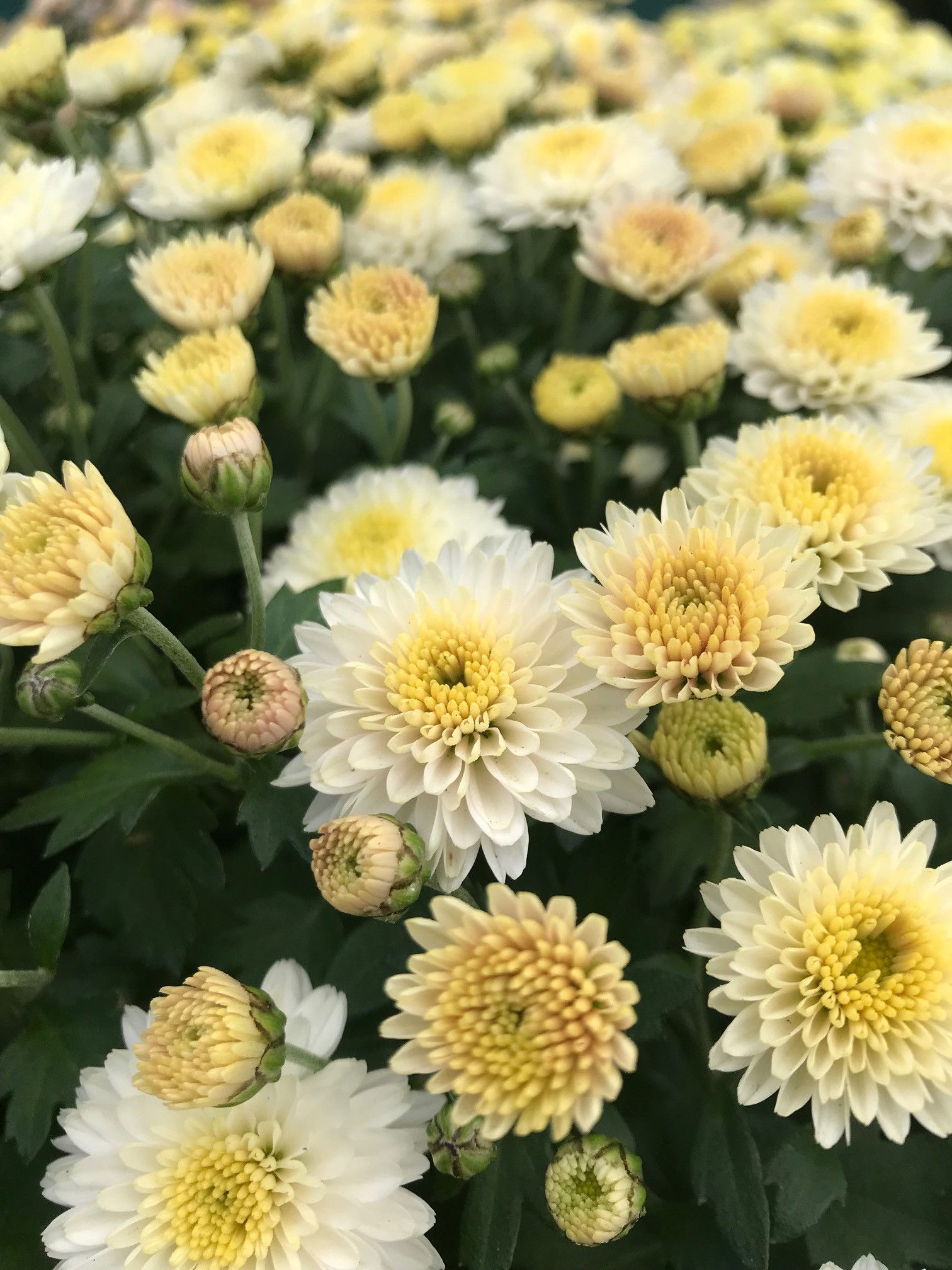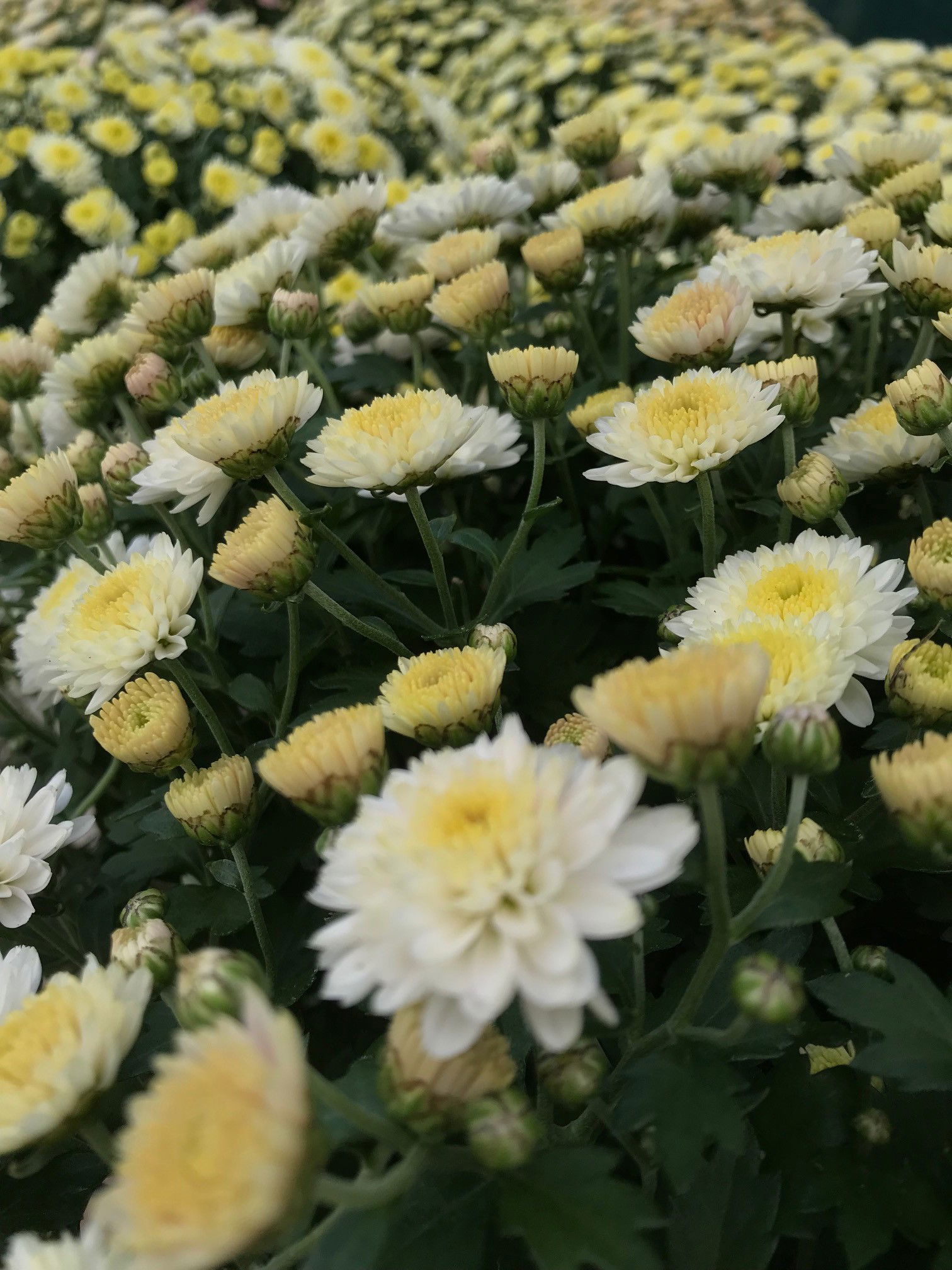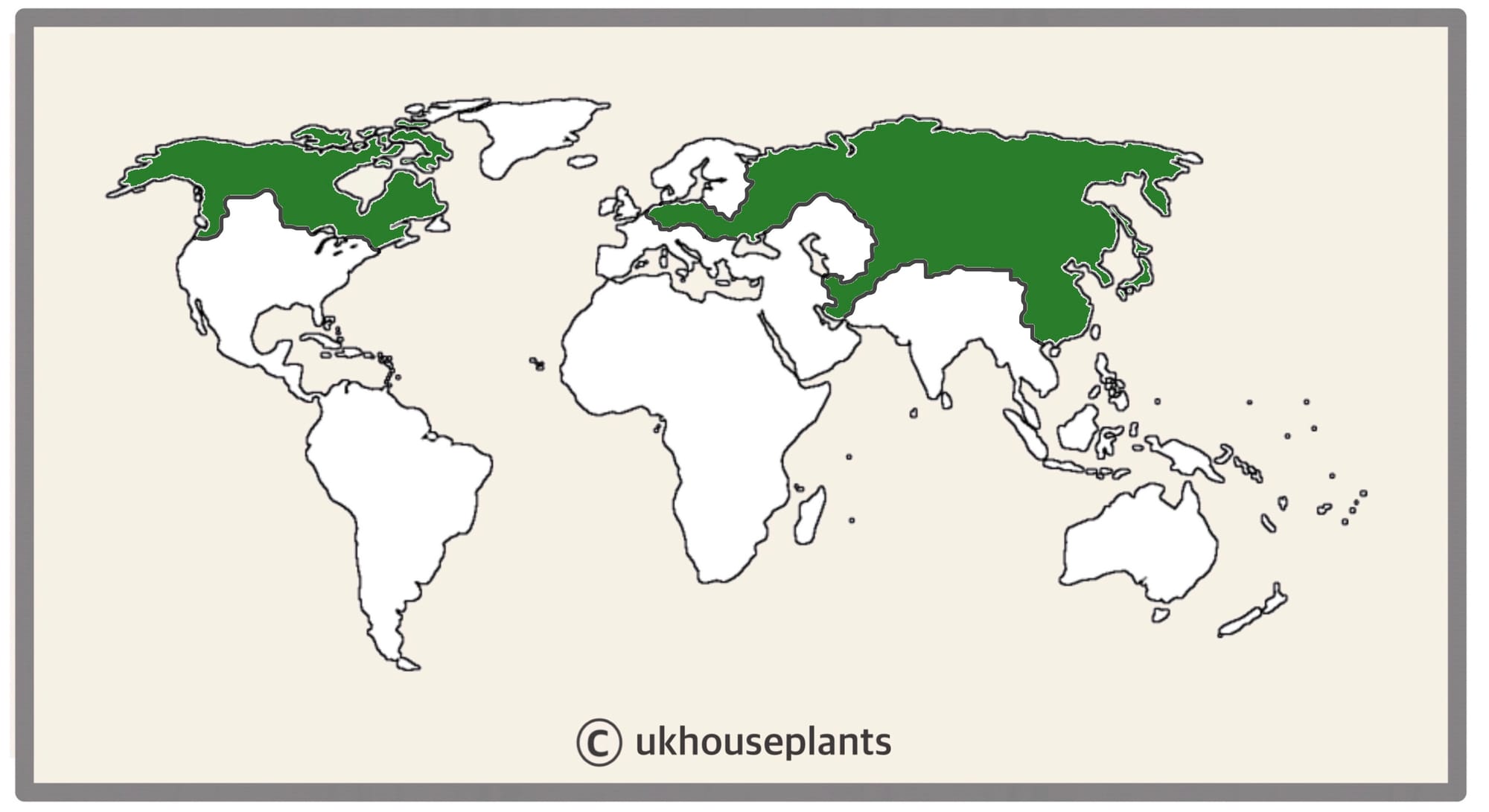
Contents
- Top Tips
- Location, Water, Humidity & Fertilisation
- Dormancy Period & Annual Flowers
- Common Issues
- Origins, Temperature, Propagation, Repotting & Toxicity.
Need the answer to a specific plant query? Book a 1-to-1 video call with THE HOUSEPLANT DOCTOR™, the website's friendly author, to overcome and address your niggling problem! Available on iMessage, WhatsApp, Facebook Messenger & more.
Top Tips & Info
- Care Difficulty - Moderate
- Keep the soil evenly moist whilst in flower, using the bottom-up method of irrigation.
- Average room humidity is more than acceptable for Chrysanthemums, but remember not to situate it within three metres of an operating heat source for dehydration issues.
- Bright, indirect light is best - avoid direct sunlight and excessively dark locations for best results.
- Fertilise using a 'Houseplant' labelled feed every four waters in the spring and summer, reducing this to every six in the colder months.
- Scroll down to the 'Dormancy Care & Annual Flowers' to learn more about annualising blooms!
Location & Light - 🔸🔸🔸
A location with little to no direct light is the ideal setting for this species. If you're worried about its site being too dark, if a newspaper can be read while having your back towards the light source, you're good to go.
In terms of the ideal room, as long as the desired location is above 15ºC (59ºF), and is at least four metres away from an operating heat source, it should be accepted by the Chrysanthemum. Do not place the plant in direct sunlight or deep shade as irreversible damage may occur in the likes of yellowed foliage and weak growth.
Water - 🔸🔸🔸
Chrysanthemums mustn't endure droughts at any point during the year, especially whilst it's in bloom. Once the top third of the soil has dried out, rehydrate by using the bottom-up method to reduce the chance of fungal diseases associated with excess moisture on the foliage. Submerge the bottom fifth of the pot in a saucer of water until thorough absorption. Repeat this step weekly, especially with those grown in bright, warmer locations. Whilst the plant is in bloom, it's essential not to use cold water as this will quickly shock the roots, causing multiple issues down the line. Under-watering symptoms include rapid flower loss and dry, sunken leaves; these issues are usually due to either forgetfulness, too much sunlight or too much heat. Over-watering symptoms include rotting lower leaves, wilting leaves, a loss of buds or flowers, heavily saturated soil and root rot. Allow the majority of the soil to dry out in between waters, preventing a pool of standing water from accumulating beneath the pot.
Humidity - 🔸🔸
Average room humidity is more than enough to occupy a Chrysanthemum, as too high humidity and poor air circulation will result in powdery mildew. Do not mist the flowers as this will cause botrytis petal blight that can spread quickly if not dealt with accordingly.
Fertilisation - 🔸🔸
Fertilise every four waters during the growing period before reducing this to every six in the autumn & winter. Although an 'All-Purpose' fertiliser will still do the job, we'd recommend using a specific 'Houseplant' labelled fertiliser as it'll support the vital thirteen nutrients that this species will need to grow.
Dormancy Care & Annual Flowers
Provide a bright, and cool autumn and winter period around 15℃ (59℉) to reinforce its dormancy. Keep the roots pot-bound to add further stress onto the specimen, which in turn will significantly heighten the chance of flowering. Blooms will generally appear in the summer, during the active growth season.
Although indoor Chrysanthemums aren't the same as the hardy species used in beds or borders, they'll both naturally flower in the warmer months of the year. Now, you're probably wondering why it's in bloom in the cooler months of the year? The answer is to do with unnatural lighting hours and fertilisers high in potassium to entice the plant to flower in time for winter. With this in mind, you may have to wait up to fifteen months to get in line again with the seasons. The following steps should be taken from early autumn until the end of winter.
Sunlight & Location
Be sure to provide a bright location with little to no direct sunlight. Although the winter rays won't necessarily hurt the plant, be careful not to fall in the trap of sun-scorch and severe dehydration. Avoid deep shade and the use of artificial lighting at night or locations that boast temperatures higher than 18℃ (64℉).
Hydration
Reduce waters so that at least half of the soil becomes dry. It's essential to keep them on the drier side to life, as they'll think that hard times are ahead and therefore will need to pass its genes on to the next generation.
Occasional Feeds
During the autumn and winter, fertilisation should be performed at monthly intervals with a 'Houseplant' feed. While the flowers are in development or in bloom, use a 'Tomato' fertiliser to provide fortnightly nourishment of potassium.
Reduce Everything
This is to remind you that everything needs to be reduced - especially the temperature.
Temperature
This is the most significant step; reduce the temperature down by around 5℃ compared to the summertime or place in a room that's between 14º - 17℃ (57º - 62℉). You'll be at a significant disadvantage if the ambient temperature is kept constant throughout the year, as Chrysanthemums will only respond in locations that have daily fluctuations of around 7℃. Never exceed the minimum temperature as it may lead to plant death or yellowed foliage at a bare minimum. If these steps are followed successfully, you could see a show of blooms in the following summer - but remember, dealing with nature may not always provide the results you'd relish.
Common Issues with Chrysanthemums
Heavy soil and mould developing on the soil means two things - too little light and over-watering. Despite the harmlessness, it'll prove unsightly to most gardeners and is therefore removed once known. To remove, replace the top two inches of the soil for a fresh batch of 'Houseplant' compost. Either increase the amount of light received (no direct sunlight for the first few weeks to prevent environmental shock) or decrease the frequency of waters slightly. If the mould is accompanied by yellowing lower leaves, you may also have a case of root rot.
Under-watering is the biggest issue when it comes to a Chrysanthemum. Typical signs of this include wilting, sunken leaves, rapid flower or bud drop and stunted growth. Not only will you have to be mindful of persistent droughts, think about which plant parts to keep dry. Its foliage must also remain dry at all times to prevent the development of diseases and blights. Chrysanthemums situated in direct sunlight or within four metres of a radiator are more likely to suffer from under-watering related issues.
Too much sunlight will lead to sun scorch, with typical signs including browning or crispy leaves, dry leaf-edges, sunken leaves or stunted growth. Although too little light will cause over-watering issues, too much sunlight will be a detriment, too. If yours has fallen short of this, reduce the amount of sunlight considerably and always be mindful of environmental shock (when too locations offer too different growing conditions). Remove some of the affected leaves and increase waters slightly. Only hydrate the plant using the bottom-up method.
As mentioned before, powdery mildew and botrytis are major threats among heavy foliage plants due to the compact nature that aids the spread of the diseases. Watering above the foliage will allow excess moisture to sit in the cubbyholes of the stem, enticing harmful bacteria to thrive. Remove the affected areas and improve the growing conditions by situating the plant in a brighter location with the use of the bottom-up method of irrigation.
Never situate a Chrysanthemum in direct sunlight or within four metres of an operating heat source, for instance, a radiator or fireplace. Due to the heightened temperature, the plant will soak up far more moisture than those situated in cooler locations, increasing the chance of droughts.
Sudden flower loss can be caused by an array of different issues, including a change in location, too little hydration, too hot or cold temperatures or droughts and pests. Whilst the plant is in bloom, keep the soil evenly moist, to hydrate the thirsty work of producing flowers. Locations that are outside of the recommended temperature bracket, or have drastic fluctuations must also be kept off the cards, as Chrysanthemum can be very sensitive to the ambient warmth that they're situated in. The final issue could be to do with pests. Although it's highly unlikely that an infestation will cause a sudden change in health, have a quick inspection for Vine Weevils (located in the soil), Spider Mites, Aphids and Thrips.
A lack of flowers is caused by an insufficient dormancy period, served in the winter months. Locations that offer near-similar temperatures all year round won't allow the plant to go dormant, resulting in low spring growth. To achieve, situate in a location that dips to around 12°C (54°F) with fewer waters. Allow the majority of the compost to dry out and provide a humidity tray while the radiators are operating.
 Chrysanthemums have been a popular plant since the Chinese used it as a herb in the sixteenth century.
Chrysanthemums have been a popular plant since the Chinese used it as a herb in the sixteenth century.
Origins
There are over fifty species of Chrysanthemums that originated from Eastern Europe to Asia. The genus was first described back in the mid-eighteenth century by Carl Linnaeus who named the species after the Greek words, chrys 'golden' and flowers, anthos, which refer to the most common coloured flower in the genus.
 The Distribution of Chrysanthemums.
The Distribution of Chrysanthemums.
Temperature
10° - 25°C (50° - 78°F)
H1c (Hardiness Zone 11) - Can be grown outdoors between late spring and summer throughout most of the UK while nighttime temperatures are above 8℃ (46℉). If you decide to bring the plant outdoors, don't allow it to endure more than an hour of direct sunlight a day as it may result in sun-scorch. Regularly keep an eye out for pests, especially when re-introducing back indoors.
Chrysanthemums thrive in cooler locations and will generally flower better if a good dormancy is served in winter when the temperature dips below 12°C (54°F).
Spread
Up to 1m in height and 1m in width. The ultimate height will take between 4 - 6 years to achieve.
Pruning & Maintenance
Remove yellow or dying leaves, and plant debris to encourage better-growing conditions. While pruning, always use clean utensils or shears to reduce the chance of bacterial and fungal diseases. Never cut through yellowed tissue as this may cause further damage in the likes of diseases or bacterial infections. Remember to make clean incisions as too-damaged wounds may shock the plant, causing weakened growth and a decline in health.
It's quite tricky for amateurs to shape a Chrysanthemum, as it'll take a significant effort over the year to promote a globular shape. Instead, allow the flowers to fully elapse (usually in mid-autumn) before pruning the foliage back 30%.
Propagation
Via Seed or Stem Cuttings.
Stem & Eye Cuttings (Moderate) - This method of propagation is troublesome without the aid of bottom-heat and a controlled environment. Choose the healthiest, most established stems that are wooded, yet still juvenile enough to bend slightly, being just thicker than a phone charger wire. Each cutting should only have a few leaves leaf, above 8cm of semi-wooded stem. Situate the cutting's lower half into moist 'Houseplant' compost; 'Blackleg' can occur when the bottom wound becomes infected, resulting in propagation failure - typically caused by water-logging or deep damage. Maintain bright light and evenly moist soil with the avoidance of direct sunlight or cold draughts. Wrap the pot (& foliage) in a transparent bag or within a miniature greenhouse, and provide bottom heat of temperatures above 18°C (54°F). Remove the bag and place into individual 7cm pots once the second new leaf emerges. Follow the same care routines, as mentioned in the article's top half. This method will take up to five months, so patience and the correct environment are paramount for success!
Flowers
Chrysanthemums will flower between the summer and autumn if grown correctly with a good dormancy served in the winter months. Each individual flower will last up to two weeks, with the overall show lasting up to six weeks. Supplement the plant using a fertiliser high in potassium to prolong its flowers - Streptocarpus or Tomato feeds are an excellent choice!
Repotting
Repot every two years in the spring, using a 'Houseplant' labelled potting mix and the next sized pot with adequate drainage. Chrysanthemums are far better potbound for several years due to the heightened risk of root rot and repotting-issues (like transplant shock), so only repot if you feel it's wholly necessary - restricted root growth will also increase the chance of blooms, too.
Hydrate the plant 24hrs before tinkering with the roots to prevent the risk of transplant shock. For those situated in a darker location, introduce an extra amount of perlite and grit into the deeper portion of the pot to downplay over-watering risks. Click on this link for a detailed step-by-step guide on transplantation, or via this link to learn about repotting with root rot.
Book a 1-to-1 video call with THE HOUSEPLANT DOCTOR™ if you'd like a personal guide to repotting your houseplant. This will include recommending the right branded-compost and pot size, followed by a live video call whilst you transplant the specimen for step-by-step guidance and answer any further questions!
Pests & Diseases
Keep an eye out for mealybugs, aphids, scale, thrips, fungus gnats, whitefly, blackfly, vine weevils & root mealybugs that'll locate themselves in the cubbyholes and undersides of the leaves, with the exception of the latter two in the soil. Common diseases associated with Chrysanthemums are root rot, leaf-spot disease, botrytis, rust, powdery mildew & southern blight - click here to learn more about these issues.
Toxicity
This plant is slightly poisonous. If parts of the plants are eaten, vomiting, nausea and a loss of appetite could occur. Consumption of large quantities must be dealt with quickly; acquire medical assistance for further information.
Retail Locations
Some florists & online stores. Specimens are likely to be found in summer outside at most garden centres. A small selection of Chrysanthemums are sold during Christmas, but generally don't last as long as those sold earlier in the year. It's not advised to bring outdoor specimens inside as this could lead to environmental shock or the introduction of foreign pests into the home.
Book a 1-to-1 Call with THE HOUSEPLANT DOCTOR™
If you need further advice with your houseplants, book an advice call with ukhouseplants' friendly and expert writer today! This can be done via a video or audio call on most apps, including Facebook, FaceTime & Skype. A ten-minute call costs £6.95 (US$8), or £15.95 for thirty minutes. You can ask multiple questions, including queries on plants, pests, terrariums, repotting advice and anything in between. Please consider supporting this service to keep ukhouseplants thriving!